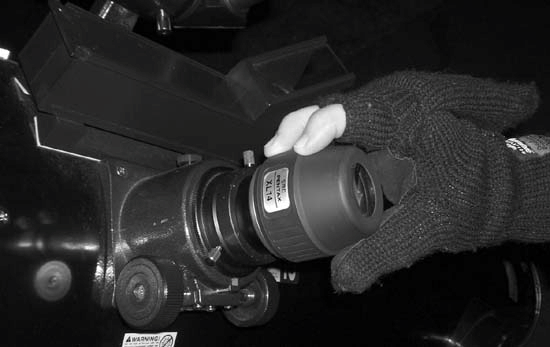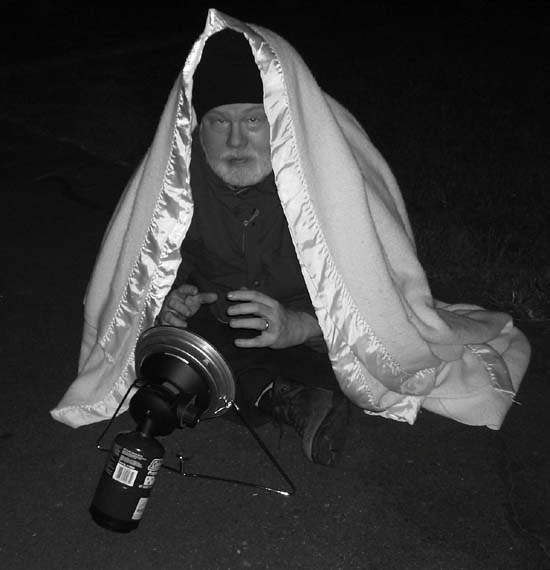Hack4.Stay Warm
Hack 4. Stay Warm
Hypothermia kills, and frostbite isn't much fun either. Learn how to protect your vital organs and keep all your extremities attached. As odd as it sounds to non-astronomers, it's possible to become chilled while observing even during high summer. Observing is a sedentary activity, so you generate little excess body heat. The temperature of the night sky is very nearly absolute zero, and it serves as a gigantic heat sink that sucks the warmth out of you. Observing sites are often located at high elevations and unsheltered from the wind, which makes the problem worse. When our astronomy club holds public observations at a local state park in July and August, it's easy to tell the experienced astronomers from the public visitors. The visitors are wearing the same t-shirts and shorts they wore during the heat of the day. The astronomers are wearing long-sleeve shirts and jeans, and often don jackets and caps as the night goes on. More than once, we've loaned blankets to visitors who were shivering, unable to figure out why they were cold. The night sky gets you every time. For cold-weather observing sessions, the problem is much worse. The standard advice is to dress for temperatures 20°F to 30°F (11°C to 17°C) colder than the actual temperature, counting wind chill. For example, if the forecast low temperature is 30°F including the effects of wind chill, we dress for 0°F to 10°F, and are often none too warm at that. Fortunately, there are steps you can take to remain warm even under severely cold conditions. 1.5.1. Avoid AlcoholEven moderate alcohol consumption increases the risk and severity of hypothermia. Alcohol is dangerous in three ways. First, it increases the likelihood of hypothermia by increasing heat loss from your body. Second, it masks the effects of hypothermia by reducing shivering and other hypothermia symptoms. Third, and most dangerously, it gives you a false sense of feeling warm. Drinking alcohol before or during an observing session is always a bad idea, but it's a particularly bad idea for cold-weather observing sessions. 1.5.2. Dress in LayersTwo basic principles of keeping warm are that many thin layers of clothing are better than a few thick layers, and that loose layers are better than tight layers. Using several thin, loose layers of clothing traps your body heat most efficiently.
For a routine cold weather observing session, Robert wears underwear, long underwear, and jeans on the bottom, and long underwear, a t-shirt, a thin turtleneck, a sweater or sweatshirt, a flannel shirt, and a parka on top. For colder sessions, he wears underwear, long underwear, flannel-padded jeans, and sweatpants on the bottom, and adds two or three layers on top, including a hooded sweatshirt. Barbara dresses similarly, but dislikes jeans. She prefers to start with a heavy pair of sweatpants, paired if necessary with long underwear for added warmth. If it is very cold or windy, she adds a second pair of of sweatpants.
1.5.3. Keep Your Head and Neck WarmYour head is an amazingly efficient heat radiator, and your neck isn't far behind. If you dress warmly otherwise but do not protect your head, you will be cold. Even for summer observing sessions, it's worth wearing a baseball cap or similar light hat. For cool or moderately cold sessions, wear a knitted watch cap. From late fall to early spring, supplement the watch cap with a thin balaclava to cover your face and neck. During very cold weather, wear a fur-lined hat with ear flaps over the balaclava, and use a scarf to keep your neck warm. 1.5.4. Keep Your Feet WarmIt always amazes us to see some astronomers during cold weather observing sessions waddling around like penguins, bundled up in parkas, but wearing tennis shoes. Your feet are second only to your head in heat loss, and it's impossible to be warm if your feet are cold. To keep your feet warm, start with two layers of socks. Use a thin, cotton or polypropylene inner layer and a thick, woolen outer layer. For extreme cold, consider heated socks, which are powered by a battery pack and available from outfitters and hunting supply stores. Some observers place a scrap of carpet or a foam pad near their telescopes, standing on it to isolate their feet from the cold ground. Choose your footwear according to the temperature. For cool or normally cold sessions, wear ankle-high hiking or walking boots. For very cold sessions, wear insulated calf-length hunting boots, such as those sold by L.L. Bean (http://www.llbean.com) and other outfitters.
1.5.5. Keep Your Hands WarmAlthough you lose less heat through your hands than through your head or feet, it's still important to keep your hands warm, not least to avoid dropping eyepieces and other equipment. A thin pair of cotton gloves or polypropylene glove liners may be all you need for moderately cold temperatures. In freezing temperatures, thin gloves keep your skin from freezing to eyepieces and other metal objects. For cold weather observing, supplement or replace the thin gloves or glove liners with heavy gloves or mittens. Mittens are warmer than gloves but are cumbersome when you are handling equipment or jotting down something in your observing log. We found the best of both worlds in the hybrid fingerless glove/mittens shown in Figure 1-1. When you're writing in your observing log or otherwise need your fingers unencumbered, you simply flip up the mitten pouch portion to expose your fingers. When you're finished, flip down the mitten pouch to cover your fingers. You can even put a small chemical heating pack in the pouch to keep your fingers toasty warm. Figure 1-1. Open-finger glove/mittens keep your hands warm while allowing full dexterity 1.5.6. Drink Plenty of Warm FluidsFor cool or cold weather observing sessions, always bring along a large Thermos of hot cider, coffee, tea, or cocoa. (Go light on the caffeine, which may exacerbate hypothermia.) Not only does drinking warm liquids help keep you warm, it helps prevent dehydration. Cold air, even if the relative humidity is high, contains very little moisture. Every time you inhale, your lungs warm and hydrate the cold, dry air. Every time you exhale, you lose that moisture to the outside air, where it is visible as it condenses as fog. Dehydration exacerbates the effects of hypothermia, and should be avoided at all costs. For very cold weather observing sessions, it's a good idea to take along a propane camp stove and use it to make hot drinks at least every couple of hours. 1.5.7. Screen Yourself from the WindEven a slight breeze can make cold air feel frigid and frigid air positively Antarctic. Screening yourself from wind makes a major difference in observing comfort. The most important step is to wear wind-resistant nylon outer clothing. All parkas have a nylon outer shell, of course, but don't overlook wind-resistant outer pants, hats, and glove shells. If there is a breeze, choose where to set up your scope with that in mind. Moving just a few feet may allow you to screen your equipment and yourself with trees, outbuildings, or other objects. For cold-weather sessions, our club members sometimes park their vehicles in a laager to provide a central screened observing area. Even if you are alone, you can park your vehicle upwind of your equipment and observe in its lee. If your vehicle is dark adapted [Hack #45], keep your charts, logs, and other working material inside the vehicle. You can study charts, record observations, and so on from the shelter of your vehicle, exposing yourself to wind only while you are actually locating and observing objects. 1.5.8. Use Supplemental Heat SourcesRegardless of how warmly you dress, you may need supplemental heat to stay warm. Many experienced cold-weather observers use one or more of the following solutions:
Coleman (http://www.coleman.com) offers several models of catalytic propane heater that produce from 1,100 to 3,000 BTU/hour. (We recommend the 3,000 BTU/hour units for astronomy.) These heaters use disposable 16.4 ounce propane cylinders, which sell for a couple bucks at any hardware store and last from 8 to 18 hours, depending on the output of the unit. Catalytic propane heaters burn with a soft orange glow that is barely visible, even when you are fully dark adapted. We don't want to overstate the amount of heat these units put out. You won't even notice the heat as you move around your observing site. In fact, the first time we fired ours up, we thought it hadn't started. It takes several minutes for the unit to start completely, and even once it's started, the heat is not obvious in the open air unless you are quite close to the unit. But 3,000 BTU/hour is a significant amount of heat if you concentrate and contain it. Figure 1-2 shows Robert warming himself with our catalytic propane heater. The blanket acts to trap the heat, and after a couple of minutes it becomes comfortably warm inside the impromptu tent. If you or one of your observing buddies has a van, that provides the ideal solution. Simply place your catalytic heater in the van at the beginning of your observing session and start it running, leaving a window cracked a few inches for ventilation. Depending on how well the van is insulated, a 3,000 BTU/hour catalytic heater can raise the interior temperature by 20°F or more, providing a warm refuge for your observing group. Don't forget that your coat and other cold-weather clothing are as good at keeping heat out as they are at keeping it in. When you're in the refuge, open or remove your coat to allow the heat to warm you.
Figure 1-2. Robert warming himself with our catalytic propane heater |
EAN: 2147483647
Pages: 112

